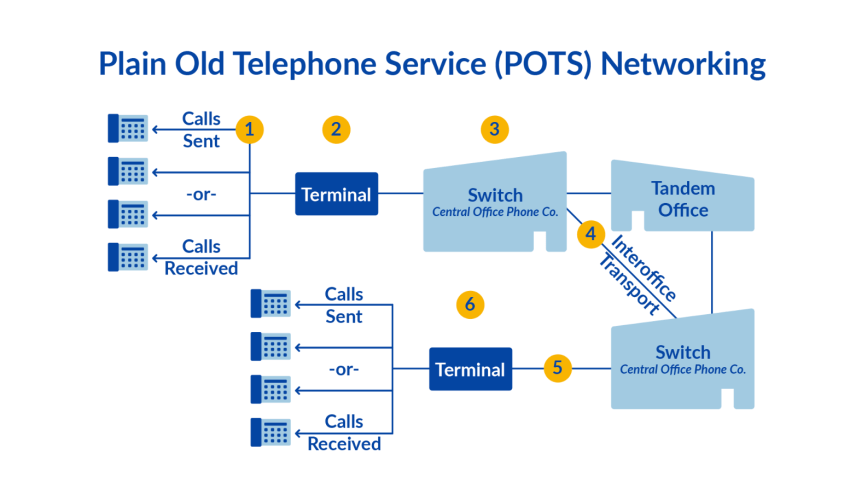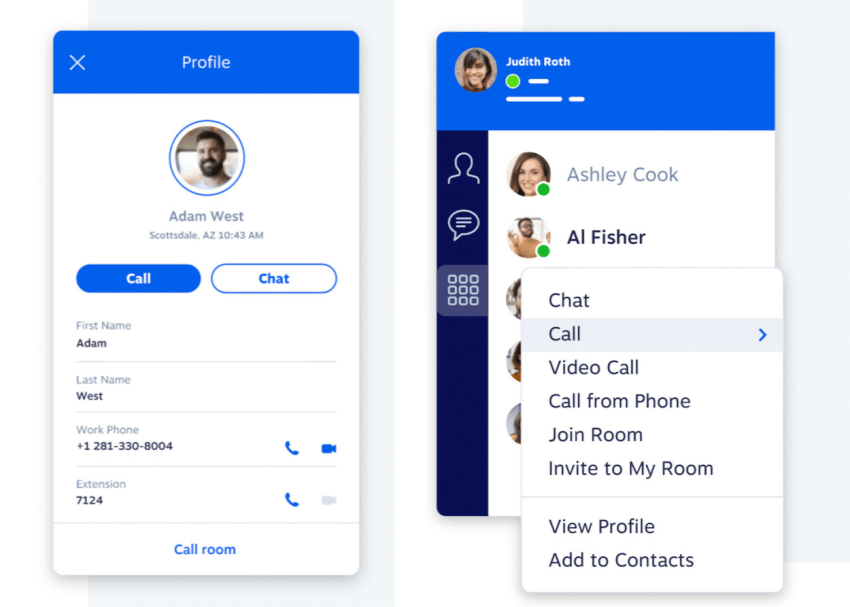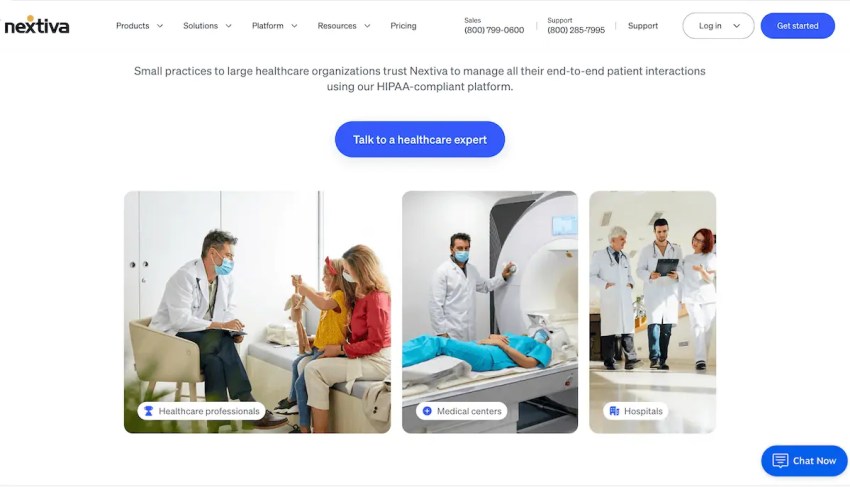The way most companies work today — often combining in-office work with remote and hybrid approaches — really challenges the business communication side of things.
How can you make sure your communication, both internal and external, runs smoothly and solves issues efficiently?
With a conventional PBX phone system, you can’t. But with a cloud-based PBX (which uses VoIP technology), the sky’s the limit because you can shape it to exactly what your business and working style needs.
If you’re thinking about a PBX replacement and moving to a VoIP phone system, this guide is for you. We’ll show you how to make the move in four stages.
Why Should Your Business Replace Its PBX System?
If you answer “yes” to any of these questions, you’re probably ready for a PBX replacement:
- Your on-premise PBX is reaching end-of-life (EOL)
- Your vendor no longer supports the on-prem PBX
- Your PBX system lacks the flexibility you need to grow your business
- You want to reduce costs
- You want to enable remote/hybrid work
As you know, private branch exchange (PBX) operates on a company’s internal telephone network. It handles calls to and from the outside world and provides features such as customized greetings and call routing.

But the PBX setup has significant limitations. The more fast-moving your business is, the bigger the barrier a traditional PBX becomes.
Here’s what makes your on-premises phone system a hassle:
- High set-up cost: Equipment, installation, and space, such as a server room, are quite an expense. PBX setup costs around $1,000 for each user, plus hardware costs.
- Maintenance challenges: You need an on-call or in-house IT expert for any troubleshooting. Ongoing costs of a PBX system can be up to $100 per month for each user.
- Limited scalability, flexibility, and upgrade options: Each new user requires adding a new physical phone line, and opening new locations or offices is a big, costly endeavor.
- Dependence on physical infrastructure: Many changes you want to make to your PBX phone system require the presence of an expert, as well as potential downtime.
- Lack of integration with modern business tools: Want to integrate with a CRM, a webinar tool, or a team chat app? Tough luck.
For these reasons, many businesses are choosing to move to a cloud-based PBX platform powered by VoIP technology. This unified communications approach that can do it all — business phone, email, video conferencing, and collaboration in one place and on any device.
Having some last-minute doubts whether a cloud-hosted PBX is right for you? Here’s how it compares to an on-premises PBX. Cloud PBX vs. On-Premises PBX:

Top Benefits of Switching from PBX to VoIP
Going the cloud-based route makes everything about your business phone system better, including:
- Greater flexibility and scalability. As your business grows, you’ll need to add extra phone lines for new employees, expand your call center capacity during holidays (and reduce it after), or open new locations and offices. With cloud PBX (using VoIP technology), you don’t need additional physical infrastructure, new copper wires, or an onsite consultant. All it takes is a tweak in your admin dashboard to adjust your phone system.
- Cost savings. Hosted PBX requires little to no upfront investment—no huge server rooms, analog phones, or expensive maintenance. All you need is an internet connection and compatible devices such as laptops and smartphones. You’ll pay a predictable monthly fee (often starting around $15 per user), and your VoIP provider takes care of updates, support, and upkeep.

- Advanced features. VoIP supercharges basic phone calls with features such as voicemail-to-email, auto attendants, call recording, call routing, and advanced call management. Many systems also include video conferencing, SMS messaging, and live chat/chatbots.
- Useful integrations. Cloud PBX also lets you integrate your telephony with powerful tools you already use, like a helpdesk platform, a CRM tool, or a collaboration platform. Instead of jumping from one tool to another to log customer conversations, everything happens automatically.
- Mobility and remote work. Do you have remote employees or those who travel regularly? With a VoIP softphone app, employees can access your phone system to make and receive calls from anywhere with an internet connection. This way, you can keep continue customer conversations or internal collaboration without a moment of friction.

- Reliability and uptime. Cloud-based telephony is secure and reliable because it runs on multiple, carrier-grade data centers designed for constant availability. Nextiva’s network ensures 99.999% uptime with encryption, continuous monitoring, and built-in failover systems that keep your business running smoothly even during outages.

The Ultimate PBX Migration Checklist
A successful PBX replacement plan is made of four stages:
- Stage 1: Pre-migration planning
- Stage 2: Technical preparations
- Stage 3: Migration
- Stage 4: Post-migration
Let’s go through each of these four steps in detail to help you transition from your old PBX phone system to a VoIP system, particularly important for contact center migration.
Stage 1. Pre-migration phone system planning
In the planning stage, there are three essential tasks for you to complete.
🔲 List requirements you need from your phone system
When choosing a business phone service, start with a list of what you need so you can match it to a provider that offers those features. For instance:
- The number of lines and extensions: How many employees do you have that need their own phone line? What about departments and specific phone extensions for each?
- Must-have communication features: Consider national and international minutes, HD phone calls, auto attendant, call routing, voicemail features, call screening and recording, call forwarding, and custom hold music.
- Business tool integration: What types of tools and specific providers do you want to integrate with your new phone system? Important ones might be: CRM, helpdesk, productivity, or collaboration tools.
🔲 Determine your budget and the costs you’ll incur
Setting up a cloud phone system won’t be a big expense of money or time. With most providers, all you need is your vendor to provide you with your account details and either port your existing numbers over or create new ones.
If you don’t have these already, here’s what might add to your VoIP costs: a quality broadband connection, Ethernet ports, adaptors, and IP phones (if you need them).
At this point, take some time to gauge what you’re already paying on an ongoing basis for your PBX phone system (possibly around $100 per user each month) plus any regular maintenance and hardware you’ve needed to replace over time. Compare it to what most VoIP service providers charge you monthly per user, typically ranging from $15 to $50 for rich feature sets.
🔲 Research and choose your ideal service provider
When choosing a VoIP provider that matches your needs and budget, look on review sites such as GetVoIP, G2, and Trustpilot. Analyze each provider’s website and take note of:
- Features offered: Including essential features and optional add-ons
- Pricing: How it changes based on the features you need, the payment frequency you choose (monthly or annually), and the number of users you have
- Existing phone number: Whether they port your current number so you can keep using it uninterrupted
- The SLA: The provider’s service level agreement and average uptime
You should also analyze reviews from similar customers — same industry, size, and needs as yours.
Stage 2: Network and environment prep
Here’s what matters in the technical prep stage:
🔲 Conduct a network assessment
Your VoIP phone system won’t work without an internet connection. And not just any kind — you need a high-speed broadband connection rated for at least 100 kbps for each phone line, upload, and download.
This should be a breeze for most quality internet service providers, but take some time to check this with your telecom provider for the number of phone lines you need right now and the number you might need in the future.
Also, make sure to implement Quality of Service (QoS), which is a method that prioritizes network traffic going through a router. VoIP can suffer from network congestion and jitter, creating echoes, lag, and dropped calls.
You’ll want your settings to prioritize voice traffic. Here’s what you need to know:
🔲 Take relevant security measures
Every phone call, whether with a customer or a colleague, must be encrypted. Otherwise, you’re potentially exposing your business to a data breach, phishing, spam, and malware — and a drop in customer trust.
Key VoIP security measures include SOC 2 compliance (for privacy, security, availability, and data integrity), PCI compliance (for card payments), and ISO/IEC 20071 (for security threats).
You also need call encryption with standards such as Transport Layer Security and Secure Real-Time Transport Protocol, which protect all your calls from interception.
And if you work with particularly sensitive data, such as patient information, make sure your potential provider is HIPAA compliant.

🔲 Test every integration you want to use
In the planning stage, you identified the tools you want to integrate your VoIP service with. Now, it’s time to put those integrations to the test.
For example, if you integrate your phone service with a CRM such as HubSpot, test whether the information from your VoIP provider seamlessly goes into HubSpot and vice versa. If not, speak to your provider to explore fixes and investigate if that could be an issue in the long run.
You want to make sure everything is running smoothly so you can lean on your provider for many years to come.
Stage 3. Phone system setup
The migration stage is now technically off your to-do list — these are the steps your service provider will handle for you. Still, it’s worth knowing what’s ahead.
These are the key processes that will take place in this stage of your PBX replacement process.
🔲 Back up all your PBX configurations, voicemails, and all relevant data
There’s nothing worse than knowing there was a phone number, a note, a voicemail, a setting already in place, only to realize you no longer have it. That scenario slows down your work and makes your customers wait for your support longer, which is frustrating for everyone.
Document your existing PBX configuration the best you can so you aren’t guessing later. That’s why a solid provider will make sure you can get up and running exactly where you left off with your previous PBX setup.
🔲 Port your existing phone numbers to the new phone service
Number porting is the process of transferring your existing phone numbers between your previous carrier and service provider to the new one.
For you, it means you’ll have to prove you own the numbers you’re looking to port. Your provider’s porting specialists will then work with carriers to make sure everything moves over correctly.
Talk to your provider to test your existing numbers after they’re ported over to verify they’re functional and work flawlessly — you want to ensure that your customers don’t hit a dead end when reaching out to you.

🔲 Set up system configuration to match your needs and workflows
Double-check how your phone system is set up and whether it matches what you need it to do. This can include:
- Extension numbering scheme for each location or department.
- Toll-free numbers for non-local customers in key geolocations.
- Advanced call routing and call flows based on business hours, menus, extensions, or departments.
- Voicemail inboxes, including greetings, forwarding, voicemail-to-email, and voicemail-to-text.
- Custom music for callers on hold, in a queue, or being transferred.

This is how to make sure you’re up and running from day one with your new phone system — no hiccups or customer frustrations.
🔲 Train and empower your employees
You need to make sure all employees are onboarded and comfortable using your new phone system.
There are two key ways to do this:
- Run focused training sessions that highlight the crucial features and functionalities of your new phones and apps.
- Give access to a knowledge base of resources, guides, and tutorials for future reference. Lean on your provider for this — for example, Nextiva’s support center is packed with videos and guides for different features, devices, and goals.
Stage 4: Post-migration VoIP phone system launch
These are your final to-dos once the PBX migration is complete:
🔲 Thoroughly test call management features
Give everything a thorough test run with your new phone service. That can include:
- Placing concurrent phone calls to ensure clear, quality audio even during busier periods
- Calling different extensions and phone numbers at various times to check that call flows run as expected
- Verifying that business tool integrations work in both directions
- Leaving test voicemails to make sure your voicemail inbox and forwarding works
- Test-routing calls to confirm it works correctly
🔲 Monitor system performance and optimize where needed
Run regular performance tests, such as a speed test, to create optimal conditions for high-quality voice calls. Any network issues, lower bandwidth than expected, or less-than-ideal network settings can affect your customer experience.
With Nextiva Speed Test, you can examine:
- Latency
- Download and upload speed
- Packet loss
- Jitter
Pro Tip: If you see less than at least 100 kbps for each phone line, more than 0% packet loss, more than 70 ms ping, or more than 70 ms jitter, it’s worth reaching out to your internet service provider. It also pays to review your QoS configuration.
🔲 Collect feedback about the new system from employees
Proactively seek feedback from employees about the new system and their experience with it.

Send out a survey with questions like:
- Which features have you used so far?
- Which functionalities do you use on a daily basis?
- Have you experienced any issues or challenges with the new phone system? If so, were you able to solve it yourself and/or with help from the provider’s support team?
- Are you missing any phone system capabilities from before the migration?
- Are you able to run your communication efficiently and smoothly on a regular basis?
Use these answers to make improvements.
🔲 Ensure ongoing support from your provider to all employees
Your business VoIP provider should offer support so well that you’ll never have to worry about individual employees struggling with a service issue.
During your training and on an ongoing basis, clearly inform your team of the best ways to reach support and the standards to expect from it. The best providers make sure you’re always happy with their service, not just during setup and onboarding.
Nextiva’s approach to customer support is called Amazing Service® — we make sure our tech always works. But if you need to reach out to us, we’ll take care of everything.
PBX to VoIP Migration Checklist
Stage 1. PBX migration planning
- List everything you need from your phone system
- Determine your budget and the costs you’ll incur
- Research and choose your ideal service provider
Stage 2. Network and environment prep
- Conduct a network assessment
- Take relevant security measures
- Test every integration you want to use
Stage 3. Phone system setup
- Back up all your PBX configurations, voicemails, and all relevant data
- Port your existing phone number to the new phone service
- Set up system configuration in a way that matches your needs and workflows
- Train and empower your team members
Stage 4. VoIP phone system launch
- Thoroughly test every call management feature
- Monitor system performance and optimize where needed
- Collect feedback about the new system from employees
- Ensure ongoing support from your provider

Case Study: Shelby American
Known for its high-performance muscle cars, Shelby American overhauled their phone system to uphold their reputation for exceptional service.
Smart, ambitious businesses know that time’s running out for their old PBX system. They’re craving a modern, flexible phone service that grows and adapts to their needs.
That’s why Shelby American moved their PBX phone system to the cloud.
They constantly respond to customer service calls from across the globe, but had some issues with their communication system. They wanted to improve the customer experience, enhance team communication, and simplify common admin functions, so they began looking for another provider.
The company’s PBX migration was quick and seamless, and the calls they relied heavily on to keep their businesses running kept coming smoothly — even amid growing customer demand.

Telecom Migrations Made Easy With Nextiva
The key is choosing a provider that will help you replace your PBX system by guiding you every step of the way.
You’ll get that when you choose Nextiva’s business phone service. You’ll leave your PBX struggles in the past and communicate smarter in the present and future.
The best cloud PBX phone system SMBs love.
Get cloud-based VoIP, SMS messaging, and video conferencing in one solution. Take your business communications to the next level with Nextiva.
PBX FAQs
PBX stands for Private Branch Exchange, a private telephone network used within an organization to route internal and external calls.
Traditional PBX systems are increasingly considered outdated because of their high cost, complexity, maintenance challenges, lack of modern features, security vulnerabilities, and scalability limitations.
For these reasons, many businesses are migrating their PBX to a cloud based solution powered by VoIP technology, which are more affordable, scalable, and packed with advanced features such as video conferencing, mobile integration, and unified communications.
The main types of PBX systems are:
Traditional (Analog) PBX: Uses physical phone lines and on-site hardware to manage calls. It’s reliable but costly to maintain and lacks flexibility for remote or hybrid teams.
IP PBX: Runs over the internet using VoIP technology. It offers more features, easier scalability, and lower costs compared to analog systems but still requires on-premises servers.
Hosted/Cloud PBX: Fully managed by a service provider and accessible via the internet. It eliminates the need for on-site equipment, supports remote work, and provides enterprise-grade features with minimal maintenance.

















 VoIP
VoIP 








